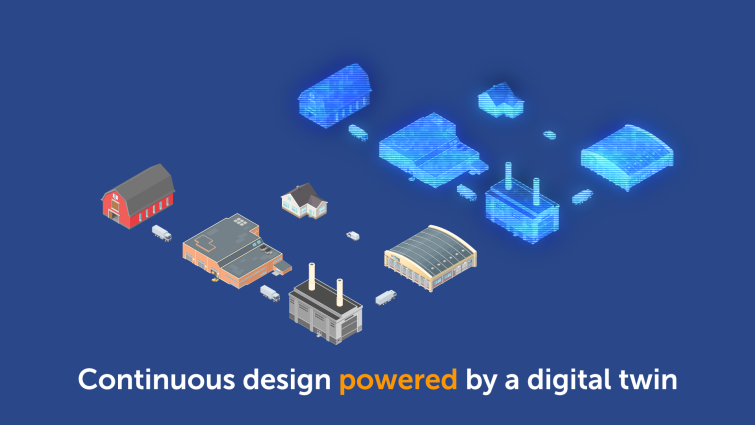The Complete Guide To Supply Chain Digital Twins

Originally Published July 19, 2022 – Updated July 21, 2022.
There was a time when people thought about supply chains like they thought about electricity: they didn’t. Everything just worked! But then a series of supply chain storms hit, and the power went out.
As companies grapple with ongoing disruptions and delays, more and more supply chain organizations are embracing digital technologies to help them design their supply chains and outsmart disruption. One critical component of this shift is the use of digital supply chain design and planning technologies, such as the digital twin.
But is a digital twin just another buzzy fad? Or is it a key component of the supply chains of the future?
Keep reading to discover:
- What is a digital twin?
- Why is a digital twin needed for supply chain design?
- How can a digital twin make my supply chain more resilient?
- Video: How a digital twin can bridge points of failure
- Can a digital twin help me meet my profitability, risk, and sustainability goals?
- How to manage supply chain risks with a digital twin
- Who should use a digital twin to design their supply chain networks?
- Examples: How companies are already employing digital twin technology
- How to turn supply chain design into a reality
What is a digital twin?
A digital twin is a digital replica of a physical supply chain. It helps organizations recreate their real supply chain in a virtual world so they can test scenarios, model different nodes, modes, flows, and policies and understand how decisions and disruptions will impact network operations.

Why is a digital twin needed for supply chain design?
Most organizations still use static spreadsheets or planning approaches based on static assumptions to design and plan their supply chains. These tools have worked just fine in the past, but many organizations have realized that applying static models to dynamic, ever-changing real-world supply chains usually comes up short. In fact, top supply chain leaders have already embraced digital twin technology.
But a digital twin equips companies to conduct these dynamic tests and redesigns. In short, it can prove transformative. Because a digital twin enables organizations to stress test their supply chain design, it is an essential component of building a supply chain that can not only withstand setbacks, but also bounce back quickly after disruptive events like blocked transportation routes, distribution center shut-downs, and so on.
Organizations use digital twins to provide greater visibility across their supply chain, identify patterns and discover opportunities for improvement, eliminate inefficiencies, and optimize current processes. Digital twins are key enablers of supply chain resilience by helping organizations make smarter, faster, data-driven decisions to respond (not react) if and when something goes wrong.
Get the eBook
How can a digital twin help make my supply chain more resilient?
Until recently, most supply chain design and planning efforts focused on planning for optimal scenarios based on a certain set of assumptions around stability, rationality, and availability of supply. But the world has changed and will keep changing. The growing threat of the climate crisis is causing more intense, more frequent, and more disruptive storms and weather events that can cause blackouts, flooding, fires, and more. Geopolitical situations feel less stable than in past decades. And the COVID-19 pandemic is unlikely to be the last global health crisis we face. These realities mean it’s even more essential that companies embrace dynamic, continuous design for their supply chains.
A digital twin helps your organization create contingency plans, figure out how much safety stock you might need, identify alternate transportation/logistics routes, and more. A digital twin is an essential component of building a more resilient supply chain. In other words, a digital twin can help you shorten the time it takes your organization to go from question to answer. And it allows you to run multiple scenarios in parallel so you can answer different questions in different strategic areas at the same time and come to the conclusion that’s best for the business overall.
A digital twin makes your existing systems work better, helps you anticipate disruption, and assists in creating a playbook of options of ways to respond to crises before they happen.
Read the blog
VIDEO: How a digital twin can bridge points of failure
Dr. Madhav Durbha, VP of Supply Chain Strategy at Coupa, often likens the digital twin to a flight similar. Watch below to learn more about this flight simulator comparison and how it can help your organization bridge potential points of failure:

Can a digital twin help me meet my profitability, risk, and sustainability goals?
Businesses want to have a positive impact on the world, and every day more and more companies recognize the importance of a double- and triple-bottom-line. Not only is embracing a social and environmental purpose the right thing to do, but regulators and consumers are also placing increasing pressure on businesses to make greater sustainability commitments.
But businesses also need to prioritize profitability. So how can business leaders find that balance?
Organizations use digital twin technology to do everything from optimizing transportation routes to reduce carbon emissions, to modeling how different raw materials and suppliers will impact their overall carbon footprint. Importantly, designing and modeling your supply chain with a digital twin helps you identify potential risks early on, so you can take action before a risk becomes a catastrophe.
If you have specific sustainability commitments but you’re not sure how certain changes in your supply chain will affect the profitability, efficiency, and continuity of your business, a digital twin can help you model all those scenarios and identify the best options to meet profitability and sustainability targets.
Read the report
How to manage supply chain risks with a digital twin
A digital twin allows you to model and stress test potential breaking points in your supply chain and then take action to improve your overall resiliency. This type of modeling also helps you:
- Test the performance of potential redesigns and changes in your supply chain before those changes become reality.
- Identify and quantify the effects of risks throughout your network.
- Choose the best response to those risks you identified.
- Analyze and compare results from numerous scenarios, while also simplifying the analysis.
- Identify the most appropriate readjustment action to take after a disruptive event occurs.
- Reduce the cost of recovery by minimizing lost sales, capital expenditures, and operational expenditures.
Who should use a digital twin to design their supply chain networks?
Any organization looking to optimize its supply chain and supply networks can benefit from a digital twin. Companies that already engage in supply chain design and planning with a digital twin range from food and beverage, to retail, to plumbing and heating, to energy, to software and technology companies.
No matter what sector or industry you work in, to get the best results, it’s important to take a thoughtful approach to build your digital twin. Here are some considerations to keep in mind:
- Know your supply chain. Really know it. Identify your existing processes and assets. Seek to understand all tiers of your suppliers. You’ll want to create an end-to-end model, whether that’s of your entire supply network or a specific segment of your production.
- Identify your data sources. Digital twins require real-time, not just historical data to continually update the model.
- Hire the right people for the job. It’s important not just to hire the right team to get your digital twin set up, but also to monitor and run the models. If you invest in a team of people to help design, test, and implement solutions, you’re more likely to identify and act on potential risks before they become big problems.
EXAMPLES: How companies are already employing digital twin technology
Microsoft
Microsoft sees data as the key to moving fast and responding appropriately to disruptions. At Coupa Inspire, an annual global community event, Cassie Wang and Jonathan Allen from Microsoft spoke about the importance of data and incorporating carbon emissions as a core metric. Good data helps them make fact-based decisions so they can reduce their carbon footprint while ensuring profitability. For example, by shifting from wood shipping pallets to pallets made of alternative materials, they significantly reduced shipping costs and carbon emissions. Digital technologies, including the digital twin, also helped them navigate pandemic-related disruptions and reduce the impact of those disruptions.
A Medical Devices Company
This company saw a sudden increase in demand for respiratory care products and an equally sudden drop in demand for other medical devices they produce. Supply chain leaders needed to pivot quickly, but they didn’t have a complete view of their supply chain. Instead, the data was fragmented, incomplete, and didn’t adequately show the tradeoffs of shifting production across manufacturing, transport, and warehousing.
To solve this, the company brought all their data into one model — a digital twin — that gave them an end-to-end view of their global supply chain. The digital twin enabled them to evaluate alternative scenarios in a rapidly evolving situation and optimize their cost-to-serve.
As a result, the increased speed of project delivery led to an estimated 35% increase in value and helped them identify tens of millions in cost-to-serve savings.
How can a digital twin improve a company’s overall business spend?
As previously mentioned, a digital twin is an essential element of continuous supply chain design. Organizations that design their supply chains continuously are on their way to greater supply chain maturity and resiliency. For example, companies can run a scenario analysis: if they turn off a supplier in one region, how will that impact other areas of the business? And so on. By engaging a digital twin in continuous design, supply chain, procurement, and finance are empowered with the data they need to adapt quickly to changes in demand, production, and supply and make decisions that improve the business’s overall objectives. Learn more.
Turn supply chain design into reality
The goal of a digital twin is ultimately to make your real-world supply chains more efficient, effective, agile, and resilient. Supply Chain Design and Planning with Coupa can help you turn your supply chain vision into reality. Want to learn how? Connect with us for a demo tailored to your interests.

